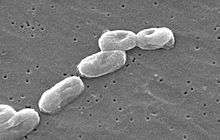Burkholderia cenocepacia
Burkholderia cenocepacia is a species of Gram-negative bacteria that is common in the environment, can form a biofilm with itself,[1] is resistant to many antibiotics[2] and may cause disease in plants.

| Burkholderia cenocepacia | |
|---|---|
| Scientific classification | |
| Kingdom: | |
| Phylum: | |
| Class: | |
| Order: | |
| Family: | |
| Genus: | |
| Species: | B. cenocepacia |
| Binomial name | |
| Burkholderia cenocepacia Vandamme et al. 2003 | |
Pathogenicity
It is an opportunistic pathogen and human infections are common in patients with cystic fibrosis and chronic granulomatous disease, and are often fatal.[3] In cystic fibrosis, it can cause "cepacia syndrome" which is characterized by a rapidly progressive fever, uncontrolled bronchopneumonia, weight loss, and in some cases, death. A review of B. cenocepacia in respiratory infections of cystic fibrosis patients stated that "one of the most threatening pathogens in [cystic fibrosis] is Burkholderia cenocepacia, a member of a bacterial group collectively referred to as the Burkholderia cepacia complex (Bcc)".[4] Twenty-four Small RNAs were identified using RNA binding properties of the Hfq protein during the exponential growth phases.[5] sRNAs identified in Burkholderia cenocepacia KC-0 were upregulated under iron depletion and oxidate stress.[6] In Seattle, a team led by microbiologist Joseph Mougous at the University of Washington had discovered a strange enzyme (a toxin called DddA) made by the bacterium Burkholderia cenocepacia — and when it encountered the DNA base C, it converted it to a U. Because U, which is not commonly found in DNA, behaves like a T, the enzymes that replicate the cell’s DNA copy it as a T, effectively converting a C in the genome sequence to a T. This might be used for some further kind of gene editing.[7][8]
See also: Burkholderia thailandensis sRNA
Taxonomy
Originally defined as B. cepacia, the group has now been split into nine species,[9] and B. cenocepacia is one of the most intensively-studied.[10]
Microbiology
In addition, the strong environmental protection response of B. cenocepacia is attributed to the biofilm formed by groups of the organism.[2] This biofilm contains exopolysaccharides (abbreviated EPS) that strengthen the bacterium's resistance to antibiotics. It is made up of a highly branched polysaccharide unit with one glucose, one glucuronic acid, one mannose, one rhamnose, and three galactose molecules. This species in the Bcc has also created another polysaccharide with one 3-deoxy-d-manno-2-octulosonic acid and three galactose molecules.[11] The biofilm exopolysaccharides acted as a barrier to neutrophils from human immune resistance systems, undermining the neutrophil defense action by inhibiting chemotaxis and reducing the production of reactive oxygen species.[12]
References
- Magdolna Csavas; Lenka Malinovska; Florent Perret; Milan Gyurko; Zita Tunde Illyes; Michaela Wimmerova; Aniko Borbas (14 November 2016). "Tri- and tetravalent mannoclusters cross-link and aggregate BC2L-A lectin from Burkholderia cenocepacia". Carbohydrate Research. Elsevier. 437: 1–8. doi:10.1016/j.carres.2016.11.008. hdl:2437/239138. PMID 27871013.
Burkholderia cenocepacia is a Gram-negative bacterium with the ability to form a biofilm
- Nida H. Alshraiedeh; Sarah Higginbotham; Padrig B. Flynn; Mahmoud Y. Alkawareek; Michael M. Tunney; Sean P. Gorman; William G. Graham; Brendan F. Gilmore (22 April 2016). "Eradication and phenotypic tolerance of Burkholderia cenocepacia biofilms exposed to atmospheric pressure non-thermal plasma". International Journal of Antimicrobial Agents. 47 (6): 446–450. doi:10.1016/j.ijantimicag.2016.03.004. PMID 27179816.
B. cenocepacia can spread from person to person and exhibits intrinsic broad-spectrum antibiotic resistance
- Magdolna Csavas; Lenka Malinovska; Florent Perret; Milan Gyurko; Zita Tunde Illyes; Michaela Wimmerova; Aniko Borbas (14 November 2016). "Tri- and tetravalent mannoclusters cross-link and aggregate BC2L-A lectin from Burkholderia cenocepacia". Carbohydrate Research. Elsevier. 437: 1–8. doi:10.1016/j.carres.2016.11.008. hdl:2437/239138. PMID 27871013.
It is recognized as an opportunistic human pathogen causing lung infections in immunocompromised individuals, especially in cystic fibrosis patients, with significant mortality and morbidity
- P. Drevinkek; E. Mahenthiralingam (2010). "Burkholderia cenocepacia in cystic fibrosis: epidemiology and molecular mechanisms of virulence". Clinical Microbiology and Infection. 16 (7): 821–830. doi:10.1111/j.1469-0691.2010.03237.x. PMID 20880411. Retrieved 6 January 2017.
- Ramos, Christian G.; Grilo, André M.; da Costa, Paulo J. P.; Leitão, Jorge H. (February 2013). "Experimental identification of small non-coding regulatory RNAs in the opportunistic human pathogen Burkholderia cenocepacia J2315". Genomics. 101 (2): 139–148. doi:10.1016/j.ygeno.2012.10.006. ISSN 1089-8646. PMID 23142676.
- Ghosh, Suparna; Dureja, Chetna; Khatri, Indu; Subramanian, Srikrishna; Raychaudhuri, Saumya; Ghosh, Sagarmoy (2017-11-03). "Identification of novel small RNAs in Burkholderia cenocepacia KC-01 expressed under iron limitation and oxidative stress conditions". Microbiology. 163 (12): 1924–1936. doi:10.1099/mic.0.000566. ISSN 1465-2080. PMID 29099689.
- Mike McRae: For The First Time, Scientists Find a Way to Make Targeted Edits to Mitochondrial DNA, on: sciencealert, July 10, 2020
- Beverly Y. Mok, M. H. de Moraes, J. Zeng, et al.: A bacterial cytidine deaminase toxin enables CRISPR-free mitochondrial base editing, in: Nature (2020). July 8, 2020. doi:10.1038/s41586-020-2477-4
- Lipuma J (2005). "Update on the Burkholderia cepacia complex". Curr Opin Pulm Med. 11 (6): 528–33. doi:10.1097/01.mcp.0000181475.85187.ed. PMID 16217180.
- Mahenthiralingam E, Vandamme P (2005). "Taxonomy and pathogenesis of the Burkholderia cepacia complex". Chron Respir Dis. 2 (4): 209–17. doi:10.1191/1479972305cd053ra. PMID 16541604.
- Chiarini, Luigi; Cescutti, Paola; Drigo, Laura; Impallomeni, Giuseppe; Herasimenka, Yury; Bevivino, Annamaria; Dalmastri, Claudia; Tabacchioni, Silvia; Manno, Graziana; Zanetti, Flavio; Rizzo, Roberto (2004-08-01). "Exopolysaccharides produced by Burkholderia cenocepacia recA lineages IIIA and IIIB". Journal of Cystic Fibrosis. 3 (3): 165–172. doi:10.1016/j.jcf.2004.04.004. ISSN 1569-1993. PMID 15463903.
- Johann Bylund; Lee-Anna Burgess; Paola Cescutti; Robert K. Ernst; David P. Speert (29 November 2005). "Exopolysaccharides from Burkholderia cenocepacia Inhibit Neutrophil Chemotaxis and Scavenge Reactive Oxygen Species" (PDF). The Journal of Biological Chemistry. 281 (5): 2526–2532. doi:10.1074/jbc.M510692200. PMID 16316987. Retrieved 6 January 2017.
We showed that EPS from a clinical B. cenocepacia isolate interfered with the function of human neutrophils in vitro; it inhibited chemotaxis and production of reactive oxygen species (ROS), both essential components of innate neutrophil-mediated host defenses
External links
- "Burkholderia cenocepacia". NCBI Taxonomy Browser. 95486.
- Type strain of Burkholderia cenocepacia at BacDive - the Bacterial Diversity Metadatabase